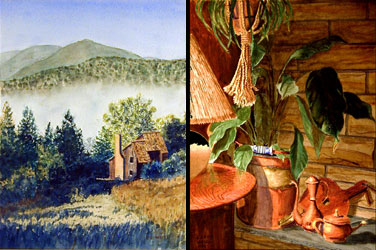

How to paint emotions using warm and cool colors.
MATERIALS LIST
Hover Or Click
A Color For Information
Burnt Sienna
A sedimentary color; sediments quickly offering a mottled or shimmery look to the final (wash)
+ close +Viridian
A sedimentary color; sediments quickly offering a mottled or shimmery look to the final (wash)
+ close +Pthalocyanine Blue
A "warm" (greenish) blue.
A non sedimentary color settles out smoothly yielding a uniform finish (wash)
+ close +Pyrrol Red
A "warm" (orangish) red.
A non sedimentary color settles out smoothly yielding a uniform finish (wash)
+ close +Arylide Yellow FGL
A "warm" (orangish) yellow.
A non sedimentary color settles out smoothly yielding a uniform finish (wash)
There is not an industry standard name for this color. I am offering DaVincis Brand name.
+ close +Yellow Ocher
A sedimentary color.
sediments quickly offering a mottled or shimmery look to the final (wash)
+ close +Cerulean Blue
A sedimentary color.
Sediments quickly offering a mottled or shimmery look to the final (wash)
+ close +Ultramarine Blue
A cool (purplish) blue.
A non sedimentary color settles out smoothly, theoretically yielding a uniform final (wash).
Actually Ultramarine Blue "flocculates" (gathers in clumps) so we only get a fairly smooth (wash)
Sadly, it's the only purplish blue thats light-fast and available to artists.
+ close +Alizarin Crimson
( Quinacridone )
A cool (purplish) red.
A non sedimentary color settles out smoothly yielding a uniform finish (wash)
n fact, Alizarine Crimson (a very early man made pigment) lost favor when it was found non light-fast.
Today we replace it it with a better version of the same color called Quinacdridone Red.
Nevertheless, manufacturers still call it Alizerine Crimson.
+ close +A cool (greenish) yellow
A non sedimentary color settles out smoothly yielding a uniform finish (wash)
There is not an industry standard name for this color. I am offering the DaVincis Brand name.
+ close +This video is an advanced lesson is about color temperature; that is, warm and cool colors, which carry the emotional impact of a painting.

Two watercolor paintings showing warm and cool colors. The warm painting on the right is predominately shades of orange and yellow. The cool painting on the left is predominately blue and green. These two paintings serve as demonstrations of how different the feelings are between the color temperatures.
All the following information is applicable to any art medium, not just watercolor painting.
I have more to say about color than about all of the other compositional elements of a painting combined. That is surprising because color is the only one that is totally subjective.
Beyond the basics of color alone (hue), is the concept of darkening the color (shades), and lightening the color (tints).
Shades and tints are referred to as neutrals and semi-neutrals. Semi-neutrals (grays) make the colors sing.
Analogous Colors are colors that are adjacent to each other on the color wheel. Within any group of analogous colors there is very little contrast. Therefore images or portions of images which are analogous are harmonious.
Complementary Colors are those colors exactly across the color wheel from each other. They are of the highest possible contrast. Because of their high contrast, they are useful for calling attention to important areas of the painting, such as the center or interest.
There are three main complement pairs.
![]() Red - Green
Red - Green
![]() Yellow - Purple
Yellow - Purple
![]() Orange - Blue
Orange - Blue
The last pair, blue and orange are especially interesting. We call blue the color if ice. Orange is the color of fire. We call the analogous colors of blue, cool colors. We call the analogous colors of orange, warm colors.
Nature is painted with cool colors, blues and greens. The cool colors come from the blue sky, also reflected in the shadows and waters, and the green of the vegetation which covers the earth. These colors remind us of the many faces of nature: verdant pastures, adventure, travel, work, play, and also dark woods, lightening, flood, night. In other words all the wonderful and not so wonderful things about the world.
People are painted with warm colors. Red, yellow and orange (brown) hair, pink babies and orange flesh. Warm is the color of love, friendship and mother.
We can use this knowledge to add feelings to our work.
I have a long standing love affair with color. This lesson is will put you on the same path.
Watercolor Painting Tutorials Watercolor Materials

A Wet In Wet Watercolor Painting Lesson.

How To Create Depth In A Painting.

Painting A Basket - A Lesson Lifting Watercolor Paint - Part 1.

Filling The Basket - A Lesson In Painting Objects Part 2.

Watercolor Lesson - Monoprinting - Texturing With Plastic Wrap.

Landscape Shadows. A Demonstration

Color For Beginners - How to mix all the colors.

Color schemes - How to plan the colors of a painting.

How to paint emotions using warm and co

Abstract Art - A discussion.